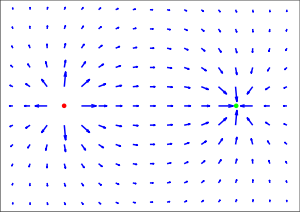Difference between revisions of "Electric field" - New World Encyclopedia
Serena Doose (talk | contribs) (imported, categories, version #) |
Serena Doose (talk | contribs) (Ready tag) |
||
| Line 1: | Line 1: | ||
| − | {{electromagnetism}} | + | {{electromagnetism}}{{Ready}} |
In [[physics]], the space surrounding an [[electric charge]] or in the presence of a time-varying [[magnetic field]] has a property called an '''electric field'''. This electric field exerts a [[force (physics)|force]] on other electrically charged objects. The concept of electric field was introduced by [[Michael Faraday]]. | In [[physics]], the space surrounding an [[electric charge]] or in the presence of a time-varying [[magnetic field]] has a property called an '''electric field'''. This electric field exerts a [[force (physics)|force]] on other electrically charged objects. The concept of electric field was introduced by [[Michael Faraday]]. | ||
| Line 100: | Line 100: | ||
This suggests similarities between the electric field <math>E</math> | This suggests similarities between the electric field <math>E</math> | ||
| − | and the gravitational field <math>g</math>, so sometimes mass is called "gravitational charge" | + | and the gravitational field <math>g</math>, so sometimes mass is called "gravitational charge." |
Similarities between electrostatic and gravitational forces: | Similarities between electrostatic and gravitational forces: | ||
# Both act in a vacuum. | # Both act in a vacuum. | ||
# Both are [[central force|central]] and [[conservative force|conservative]]. | # Both are [[central force|central]] and [[conservative force|conservative]]. | ||
| − | # Both obey an [[inverse-square law]] (both are inversely | + | # Both obey an [[inverse-square law]] (both are inversely proportional to square of r). |
# Both propagate with finite speed c. | # Both propagate with finite speed c. | ||
| Line 133: | Line 133: | ||
* [[Teltron Tube]] | * [[Teltron Tube]] | ||
| + | ==Notes== | ||
| + | ==References== | ||
== External links == | == External links == | ||
| − | *[http://www.lightandmatter.com/html_books/0sn/ch10/ch10.html Fields] - a chapter from an online textbook | + | *[http://www.lightandmatter.com/html_books/0sn/ch10/ch10.html Fields] - a chapter from an online textbook. Retrieved November 4, 2007. |
| − | *[http://www.vias.org/simulations/simusoft_efield.html Learning by Simulations] Interactive simulation of an electric field of up to four point charges | + | *[http://www.vias.org/simulations/simusoft_efield.html Learning by Simulations] Interactive simulation of an electric field of up to four point charges. Retrieved November 4, 2007. |
| − | *Java simulations of [http://www.falstad.com/emstatic/ electrostatics in 2-D] and [http://www.falstad.com/vector3de/ 3-D] | + | *Java simulations of [http://www.falstad.com/emstatic/ electrostatics in 2-D] and [http://www.falstad.com/vector3de/ 3-D]. Retrieved November 4, 2007. |
<!--Categories—> | <!--Categories—> | ||
| Line 142: | Line 144: | ||
[[Category:Physical sciences]] | [[Category:Physical sciences]] | ||
| + | {{Credit|168693464}} | ||
Revision as of 03:10, 4 November 2007
| Electromagnetism | ||||||||||||

| ||||||||||||
Electricity ·Magnetism
| ||||||||||||
In physics, the space surrounding an electric charge or in the presence of a time-varying magnetic field has a property called an electric field. This electric field exerts a force on other electrically charged objects. The concept of electric field was introduced by Michael Faraday.
The electric field is a vector field with SI units of newtons per coulomb (N C−1) or, equivalently, volts per meter (V m−1). The direction of the field at a point is defined by the direction of the electric force exerted on a positive test charge placed at that point. The strength of the field is defined by the ratio of the electric force on a charge at a point to the magnitude of the charge placed at that point. Electric fields contain electrical energy with energy density proportional to the square of the field intensity. The electric field is to charge as acceleration is to mass and force density is to volume.
A moving charge has not just an electric field but also a magnetic field, and in general the electric and magnetic fields are not completely separate phenomena; what one observer perceives as an electric field, another observer in a different frame of reference perceives as a mixture of electric and magnetic fields. For this reason, one speaks of "electromagnetism" or "electromagnetic fields." In quantum mechanics, disturbances in the electromagnetic fields are called photons, and the energy of photons is quantized.
Definition
A stationary charged particle in an electric field experiences a force proportional to its charge. The electric field is defined as the proportionality constant between charge and force in this relationship:
where is the electric force on the particle, q is its charge, and is the electric field that the particle is in.
Note that this relationship only holds when the charge is stationary; otherwise the force is determined by the more general Lorentz force equation.
Taken literally, this equation only defines the electric field at the places where there are stationary charges present to experience it. For this reason, physicists use the concept of a test charge: to measure the electric field at a point, you hold a small "test charge" there, measure the force, and compute the electric field using the above equation.
As is clear from the definition, the direction of the electric field is the same as the direction of the force it would exert on a positively-charged particle, and opposite the direction of the force on a negatively-charged particle. Since like charges repel and opposites attract (as quantified below), the electric field tends to point away from positive charges and towards negative charges.
Coulomb's law
The electric field surrounding a point charge is given by Coulomb's law:
where
- Q is the charge of the particle creating the electric field,
- r is the distance from the particle with charge Q to the E-field evaluation point,
- is the Unit vector pointing from the particle with charge Q to the E-field evaluation point,
- is the vacuum permittivity.
Coulomb's law is actually a special case of Gauss's Law, a more fundamental description of the relationship between the distribution of electric charge in space and the resulting electric field. Gauss's law is one of Maxwell's equations, a set of four laws governing electromagnetics.
Properties (in electrostatics)
According to equation (1) above, electric field is dependent on position. The electric field due to any single charge falls off as the square of the distance from that charge.
Electric fields follow the superposition principle. If more than one charge is present, the total electric field at any point is equal to the vector sum of the respective electric fields that each object would create in the absence of the others.
If this principle is extended to an infinite number of infinitesimally small elements of charge, the following formula results:
where
- is the charge density, or the amount of charge per unit volume.
The electric field at a point is equal to the negative gradient of the electric potential there. In symbols,
where
- is the scalar field representing the electric potential at a given point.
If several spatially distributed charges generate such an electric potential, e.g. in a solid, an electric field gradient may also be defined.
Considering the permittivity of a material, which may differ from the permittivity of free space , the electric displacement field is:
Energy in the electric field
The electric field stores energy. The energy density of the electric field is given by
where
- is the permittivity of the medium in which the field exists
- is the electric field vector.
The total energy stored in the electric field in a given volume V is therefore
where
- is the differential volume element.
Parallels between electrostatics and gravity
Coulomb's law, which describes the interaction of electric charges:
is similar to the Newtonian gravitation law:
This suggests similarities between the electric field and the gravitational field , so sometimes mass is called "gravitational charge."
Similarities between electrostatic and gravitational forces:
- Both act in a vacuum.
- Both are central and conservative.
- Both obey an inverse-square law (both are inversely proportional to square of r).
- Both propagate with finite speed c.
Differences between electrostatic and gravitational forces:
- Electrostatic forces are much greater than gravitational forces (by about 1036 times).
- Gravitational forces are attractive for like charges, whereas electrostatic forces are repulsive for like charges.
- There are no negative gravitational charges (no negative mass) while there are both positive and negative electric charges. This difference combined with previous implies that gravitational forces are always attractive, while electrostatic forces may be either attractive or repulsive.
- Electric charges are invariant under Lorentz transformations while gravitational charges (relativistic mass) are not.
Time-varying fields
Charges do not only produce electric fields. As they move, they generate magnetic fields, and if the magnetic field changes, it generates electric fields. This "secondary" electric field can be computed using Faraday's law of induction,
where
- indicates the curl of the electric field,
- represents the vector rate of decrease of magnetic field with time.
This means that a magnetic field changing in time produces a curled electric field, possibly also changing in time. The situation in which electric or magnetic fields change in time is no longer electrostatics, but rather electrodynamics or electromagnetics.
See also
- Electrostatics
- Electrodynamics
- Maxwell's equations are the full set of equations governing electric fields.
- Magnetism
- Teltron Tube
Notes
ReferencesISBN links support NWE through referral fees
External links
- Fields - a chapter from an online textbook. Retrieved November 4, 2007.
- Learning by Simulations Interactive simulation of an electric field of up to four point charges. Retrieved November 4, 2007.
- Java simulations of electrostatics in 2-D and 3-D. Retrieved November 4, 2007.
Credits
New World Encyclopedia writers and editors rewrote and completed the Wikipedia article in accordance with New World Encyclopedia standards. This article abides by terms of the Creative Commons CC-by-sa 3.0 License (CC-by-sa), which may be used and disseminated with proper attribution. Credit is due under the terms of this license that can reference both the New World Encyclopedia contributors and the selfless volunteer contributors of the Wikimedia Foundation. To cite this article click here for a list of acceptable citing formats.The history of earlier contributions by wikipedians is accessible to researchers here:
The history of this article since it was imported to New World Encyclopedia:
Note: Some restrictions may apply to use of individual images which are separately licensed.























